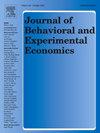用实验数据评估医生、医学生和非医学生的风险态度
IF 1.4
3区 经济学
Q2 ECONOMICS
Journal of Behavioral and Experimental Economics
Pub Date : 2025-05-22
DOI:10.1016/j.socec.2025.102384
引用次数: 0
摘要
最近,卫生经济学越来越多地使用实验室和现场实验来预测医生在不同支付系统中的行为。然而,这些研究通常将学生作为决策者,假设他们可以很好地代表真正的医生的行为,因为医生和学生的决定通常没有质的差异。采用大样本的实验数据,我们调查对风险的态度是否在医生,医学和非医学学生在货币领域显著差异。结果显示,无论采用何种评估技术,风险态度都存在显著差异,这表明恒定的相对风险厌恶是风险偏好的支持表示。最后,医生比样本中任何其他类型的参与者都更不愿承担风险,这表明他们对医疗风险的态度与其他参与者不同,至少在货币领域是如此。考虑到真正的医生由于参与障碍而难以让他们参与实验,让医科学生和非医科学生参与实验是次优选择。然而,研究人员在设计任务时必须小心,因为在不同的背景下,选择可能会有所不同。此外,政策制定者在从实验室预测中得出政策含义时必须谨慎,不要想当然地认为学生的决定与医生的决定完全一致。本文章由计算机程序翻译,如有差异,请以英文原文为准。
Assessing risk attitudes among physicians, medical students, and non-medical students with experimental data
Recently, laboratory and field experiments have been increasingly used in health economics to predict the behavior of physicians in connection with different payment systems. However, these studies often employ students as decision-makers, assuming that they are a good proxy for the behavior of real physicians, as no qualitative difference between physicians and students’ decisions is often observed. Employing a large sample of experimental data, we investigate whether attitudes toward risk varied significantly between physicians, medical and non-medical students in the monetary domain. The results show significant variation in risk attitude regardless of the estimation technique employed, suggesting constant relative risk aversion as a supported representation of risk preferences. Finally, physicians were less risk-averse than any other participant type in the sample, suggesting that medical risk attitudes differed from other participants, at least in the monetary domain. Given the difficulty in involving real physicians due to their participation barriers, employing medical and non-medical students in experiments is the second-best option. However, researchers must be careful when designing tasks because choices may differ across various contexts. Additionally, policymakers must be cautious when drawing policy implications from laboratory predictions, not taking it for granted that students’ decisions fully match physicians’ decisions.
求助全文
通过发布文献求助,成功后即可免费获取论文全文。
去求助
来源期刊
CiteScore
2.60
自引率
12.50%
发文量
113
审稿时长
83 days
期刊介绍:
The Journal of Behavioral and Experimental Economics (formerly the Journal of Socio-Economics) welcomes submissions that deal with various economic topics but also involve issues that are related to other social sciences, especially psychology, or use experimental methods of inquiry. Thus, contributions in behavioral economics, experimental economics, economic psychology, and judgment and decision making are especially welcome. The journal is open to different research methodologies, as long as they are relevant to the topic and employed rigorously. Possible methodologies include, for example, experiments, surveys, empirical work, theoretical models, meta-analyses, case studies, and simulation-based analyses. Literature reviews that integrate findings from many studies are also welcome, but they should synthesize the literature in a useful manner and provide substantial contribution beyond what the reader could get by simply reading the abstracts of the cited papers. In empirical work, it is important that the results are not only statistically significant but also economically significant. A high contribution-to-length ratio is expected from published articles and therefore papers should not be unnecessarily long, and short articles are welcome. Articles should be written in a manner that is intelligible to our generalist readership. Book reviews are generally solicited but occasionally unsolicited reviews will also be published. Contact the Book Review Editor for related inquiries.

 求助内容:
求助内容: 应助结果提醒方式:
应助结果提醒方式:


